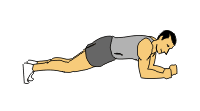1. Abdominal Muscles. You can't underestimate the importance of a strong core - for anything! This is not just about getting your tummy back into shape after baby #x. Your abdominal muscles support your back and whole torso. In addition to classic crunches and/or sit ups - to borrow from Yoga - plank and side plank are great moves to practice. Plus, it is harder for the kids to climb on top of me when I am not laying on my back!
Plank begins on your hands and feet as though you are at the top of a push up. You could also go down to elbows/feet or hands/knees to make it easier as you begin. Trying to keep your body as straight as possible as you hold this position.
 Take a break and repeat. Side plank is when you rotate onto just one hand or elbow and the outside of one knee or foot.
Take a break and repeat. Side plank is when you rotate onto just one hand or elbow and the outside of one knee or foot. 2. Deltoid Muscles (Shoulders). Let's start with exercises that don't require any equipment - except maybe for a small child if you happen to have one lying about. These are the muscles that surround your shoulders: front, back and side. You can do push ups. You can lift your child up to chin-level, keeping your elbows high ("upright row"). You can lift your child over your head ("shoulder press"). Side raises and front raises hit the right area too, but you might find that any child old enough to be handled in this manner to be too heavy.
2. Deltoid Muscles (Shoulders). Let's start with exercises that don't require any equipment - except maybe for a small child if you happen to have one lying about. These are the muscles that surround your shoulders: front, back and side. You can do push ups. You can lift your child up to chin-level, keeping your elbows high ("upright row"). You can lift your child over your head ("shoulder press"). Side raises and front raises hit the right area too, but you might find that any child old enough to be handled in this manner to be too heavy.3. Pectorals (Chest). Push ups can help here too. The traditional exercise is a chest press while lying on your back. You can try using your kid for this one too, though results may vary.
4. Triceps. These are the muscles that extend your arms. Dips off the end of a chair or bench are great. Tricep push ups keep your hands and elbows in close such that your arms brush your sides as you move up and down. If too difficult, you can do these standing upright and leaning on a wall. Tricep extensions keep your upper arms/elbows still right next to your ears while you move a weight up and down.
* I am not a personal trainer, these are just exercises that work for me.
Also, all pictures are borrowed from other websites. Please click on a picture to go to the website from which the graphic came. Thanks.

